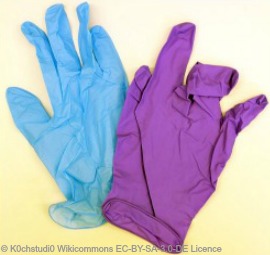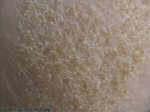Latex Allergies Can Be
Caused By Everyday Items.
Find Out What To Avoid
Latex allergies are caused by Latex. Latex is a natural substance. It is a milky fluid, or sap, that comes from the rubber tree. This tree is found in Africa and Asia.
The latex goes through a number of processes to become natural rubber.

After it has been obtained from the rubber tree it is heated and certain acids are added.
It then begins to solidify, then it is put through large rollers.
This flattens it so it can be sent out to be made into the every day items that contain it.
It is the proteins and the added chemicals in the rubber that cause the symptoms of latex allergies.
Latex allergy affects around 6% of the population. It is slightly more common in people who work in the medical profession.
Nurses, doctors and dentists, for example. They are more likely to use gloves and medical equipment that are potential irritants.
There are 3 ways that a reaction can occur
- Irritant Contact Dermatitis. It is usually caused when wearing rubber gloves. The skin sweats and causes skin irritation. Causing itchiness and redness. It is the most common reaction
- Allergic Contact Dermatitis. This reaction is caused by the chemicals used in the production process. They irritate the skin. Causing itchiness and redness, as well as blisters and weeping. As the skin heals it becomes dry and scaly
- Immediate Allergic Reaction. As the name suggests this happens almost straight after contact. It isn't just caused by contact with the skin. Particles of air containing latex protein can also be inhaled
As well as affecting the skin other latex allergy symptoms include hay fever symptoms, hives and chronic itching.
It can be a difficult everyday issue for people who have a severe reaction. Causing breathing problems, chest pain, low blood pressure and even anaphylactic shock. Although these can be very severe symptoms, fortunately deaths are rare.
What Products Can Cause Latex Allergies?
Some of the obvious items that could be an issue are
Some of the not so obvious ones are
Rubber Gloves
These include heavy duty and disposables. There are vinyl, polythene and PVC gloves that can be used instead.

If you have an allergy to latex gloves, then caution should be taken when you visit a doctor or dentist. They tend to be used during visits.
Let them know about your allergy and they will likely have alternative gloves.
If your reaction is severe then carrying some latex free gloves with you may be an option.
Condoms
Diaphragms can also cause a reaction.
If you have a latex condom allergy there are condoms available that are made of polyisoprene and sensoprene. They are like latex ones but they don’t contain the proteins that cause the reaction.
There are many brands available to buy. And different types. Some online stores sell a sample box, with a few different types in. This can help to find the right one for you.
There are also female condoms called FC2. They are fine to use as they are made of synthetic nitrile, which is safe for latex allergy sufferers to use.
There is a female condom available to buy that is made of natural latex, but in some places it is still being tested in clinical trials.
Rubber Bands
There are latex free bands that are available to buy. They are made from a sort of solid synthetic rubber. This type of rubber doesn't contain the natural rubber proteins that cause the reaction.
Balloons
Latex balloons can be a problem when touching them or when blowing them up.

A reaction can happen with direct contact or with the powder in the balloon when it is inhaled.
Foil balloons are a great alternative. There are also latex free balloons available to buy, which are made of plastic.
They stretch like latex balloons but will not cause an allergic reaction.
They are more expensive, so would probably only be an option if you have a severe reaction.
Baby Dummies and Teats
There are silicone alternatives for pacifiers and teats. Although children may not take to them. They are widely available and not much different in price.
Hot Water Bottles
There are latex free ones available to buy. They can be found in large chemists or online.
Wheat bags are also available. They are heated in the oven or microwave. They tend to have a lovely smell to them too.
Swimming Hats and Goggles
Silicone hats are widely available. They are more comfortable than latex ones as they stretch more. They also seem to last longer.
You can also buy goggles that have foam eye cup surrounds. They are slightly more expensive. There are also goggles with a latex free frame and strap.
This is a very small list. There are around 40,000 items that contain natural rubber. For a great, extensive list, the Latex Allergy Support Group, have a list of items and products that contain latex, and some alternatives.
If your reaction is severe you will be very sensitive to latex. This makes it harder to avoid it in everyday life.
Most people tend to have problems with certain items. This makes it easier to avoid them. If a reaction tends to quite immediate it makes it simpler to work out the offending items.
My Personal Story
The worst culprit that affects my latex allergies are rubber gloves. I first started wearing them to protect my hands when cleaning and preparing food. I didn't immediately realise that the gloves were a problem.
After a little while I noticed that my hands were dry and itchy after wearing latex gloves.
I did a bit of research and the connection became clear. It was quite easy to find some alternatives. They are available in some supermarkets. They are labelled as latex free. The disadvantage is that they tend to be more expensive, especially the disposable ones.
I personally would rather spend a little more. Without gloves or when wearing problematic gloves it causes my irritant contact dermatitis to rear its irritating, itchy head!
Return from Latex Allergies to Triggers of Eczema
Return from Latex Allergies to What Is Eczema
Search What Is Eczema?
Advertising on What Is Eczema?
We are a participant in the Amazon Services LLC Associates Program, an affiliate program which allows sites to earn fees by advertising and linking to amazon.com. If you make a purchase through a link on this page, I may receive a small commission, at no extra cost to you. Many thanks
